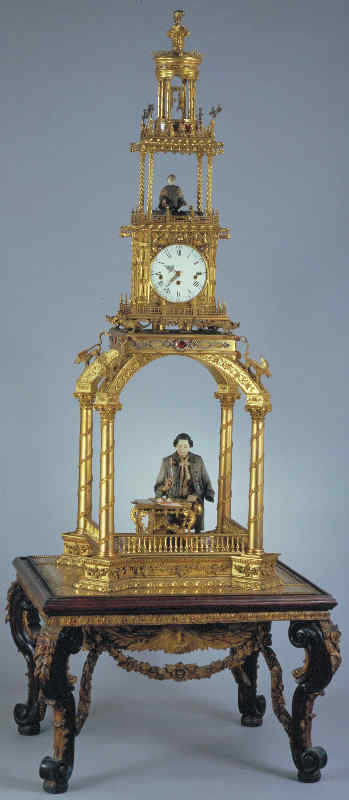Communications of the ACM
Who Manufactured the Mysterious Chinese Android?

In the 18th century, there were several famous makers of automatons in Europe (see Table 1). Vaucanson's masterpieces marked the beginning. He was involved in the development of the mechanical loom and had also invented a mechanical duck. However, his automaton figures have not survi-ved. The three androids of Jaquet-Droz are still fully functional and are regularly shown in Neuchâtel, Switzerland. The dulcimer player from Kintzing is one of the most magnificent machines. Another handwriting automaton of Knaus has been preserved in Florence. Unfortunately, only a few details about Williamson are available. The procurement of pictures in Beijing proved to be extremely complicated and time-consuming.
Description of Williamsons's "writer"
In the history of technology, the mechanical "writer" from Beijing (see figure 1) is almost unknown. Timothy Williamson's 231-cm-high functional musical clock automaton figure consists of a carved wooden coffee table on which a gilded four-story copper tower rests. The four floors house (from top to bottom): dancing figures with a scroll, jaquemart, clock, and writer. He uses a brush to write a given text consisting of eight Chinese characters on paper. The automaton is not programmable. The movements are controlled by three round gears (see Laurence Bodenmann; Morghan Mootoo- samy (ed.): Automates et merveilles, Editions Alphil, Neuchâtel 2012, pages 49-50).
Who is the author of the android?
According to Zhang and Guo, Williamson is not the author of the Chinese musical clock automaton figure: "The writer's clock, made of gilded copper. Made in England in the 18th century. With a height of 231 cm and a base diameter of 77 cm. At the time of ringing 3am-6am-8am-12am, the music works, a kneeling automaton writes the following sentence: "May the kings of all nations come to pay homage to our emperor." The clock is signed by the English master Williamson, but it is actually the work of the Swiss clockmaker Jaquet-Droz." (see Pu Zhang; Fuxiang Guo: The art of Western watchmaking and China, China international press, Beijing 2005, pages 90-91).
In the Palace Museum, there are 13 Jaquet-Droz works, including a gilded copper clock with a singing bird whose beak, wings and tail move, and other table clocks and pocket watches (see Fu Xiang Guo; Xue Ling Guan: Les collections de Jaquet-Droz au musée de la Cité interdite, in: Ni- cole Bosshart (ed.): Automates et merveilles. Merveilleux mouvements... surprenantes mécaniques, Editions Alphil, Neuchâtel 2012, pages 45-49).
Williamson or Jaquet Droz?
According to Philippe Lüscher of the Musée d'art et d'histoire, Neuchâtel (personal communication of 17 June 2019), the musical clock automaton figure could indeed be the work of Jaquet-Droz. Unfortunately, the automaton is not accessible in the forbidden city, one must not look at it from close up. The local curators do not allow the assignment to be checked. Therefore one has to be content with assumptions at the moment. What is the reason for this secrecy?

Figure 1: Musical clock automaton figure from Beijing.
This extremely rare photo shows the "writer" of Timothy Williamson
writing a given short Chinese text with a brush.
A clock is also built into the multi-storey tower; Jaquemarts announce the hours.
Credit: The Palace Museum, Beijing
References
Laurence Bodenmann; Morghan Mootoosamy (eds.): Automates et merveilles, Editions Alphil, Neuchâtel 2012, pp. 49–50
Nicole Bosshart (ed.): Automates et merveilles. Merveilleux mouvements, surprenantes méca- niques, Editions Alphil, Neuchâtel 2012
Herbert Bruderer: Meilensteine der Rechentechnik, De Gruyter Oldenbourg, Berlin/Boston 2018, 2 volumes
Herbert Bruderer: Milestones in analog and digital computing, Springer Nature Switzerland AG, Cham 2020, 2 volumes
Fu Xiang Guo; Xue Ling Guan: Les collections de Jaquet-Droz au musée de la Cité interdite, in: Nicole Bosshart (ed.): Automates et merveilles. Merveilleux mouvements... surprenantes méca- niques, Editions Alphil, Neuchâtel 2012, pp. 45–49
Pu Zhang; Fuxiang Guo: L'art de l'horlogerie occidentale et la Chine, China international press, Beijing 2005, pp. 90–91.
Herbert Bruderer is a retired lecturer in didactics of computer science at ETH Zürich. More recently, he has been an historian of technology. [email protected], herbert.bruderer@bluewin.
No entries found